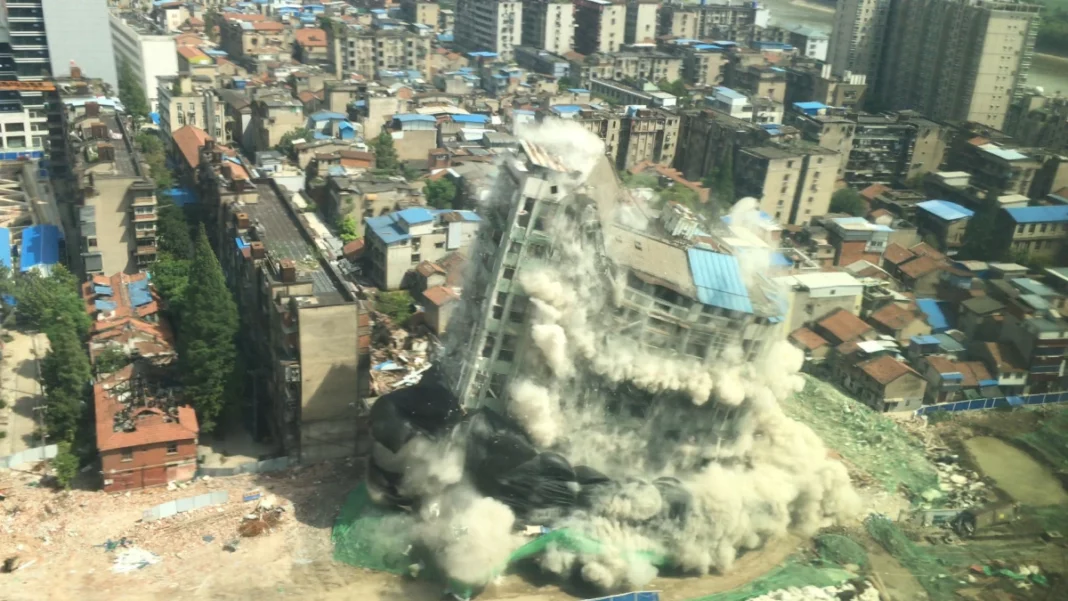The Supertech Twin Towers demolition in Noida happened on Sunday (August 28) after considerable anticipation and a nine-year court fight. The towers Ceyane (29 floors) and Apex (32 floors), which were a part of the Emerald Court project of Supertech Ltd, were determined to breach several construction regulations and were consequently demolished.
The towers had a height of about 100 meters, which makes them higher than the Qutub Minar. They were located in Sector 93A near the Noida-Greater Expressway and contain about 850 apartments. They were India’s highest tower to be demolished.
Earlier this week, preparations from charging the structures to emptying the area were made. Residents of the adjoining apartment buildings ATS Greens Village and Emerald Court had been ordered to leave by Sunday morning by the resident welfare association (RWA). According to the police, ATS village has roughly 25 towers and four villas, while Emerald Court has 15 towers.
No people or animals were permitted within the designated exclusion zone, which had a radius of 500 meters, except for the demolition team members. Moreover, eight ambulances, four fire engines, and the National Disaster Response Force were stationed on-site.
Supertech Twin Towers Demolition Reason
The New Okhla Industrial Development Authority (NOIDA) gave Supertech permission to construct 14 towers with nine floors each, a shopping center, and a garden area in 2005. But in 2009, it changed the proposal and included the twin high-rise structures Apex and Ceyane. The Emerald Court Owners Residents Welfare Association (RWA) filed a case with the Allahabad High Court in 2012, claiming that the new plan was illegally constructed even though the NOIDA authorities had approved it.
The towers were to be demolished in 2014 after the Allahabad High Court declared them unlawful. Noida Authority and Supertech petitioned the Supreme Court to overturn the ruling. The structures were demolished after the Supreme Court affirmed the Allahabad High Court’s decision on August 31, 2021.
The twin towers’ construction was judged to have violated the minimum separation standard by the Supreme Court. It asserted that the towers’ construction disregarded fire safety regulations and building requirements.
Additionally, it claimed that without the approval of the flat owners, the plan’s alteration, which involved removing the garden area to create room for the building of Apex and Ceyane, breached the 2010 Uttar Pradesh Apartments Act.
The top court authorized the prosecution of officials for violating the Uttar Pradesh Industrial Area Development Act of 1976 and the Uttar Pradesh Apartments Act of 2010 when it ordered the demolition of these two towers in August 2021. The court also claimed that the towers were built through “acts of collusion between the officers of NOIDA and company.” Despite the Court’s decision for the demolition to occur within three months, this is why Supertech Twin Towers demolition was set for August 28, Sunday.
The Demolition of Noida Supertech Twin Towers: Here’s how it happened
The Supertech towers demolition happened via a “controlled implosion,” in which the structure fell after explosives had been carefully positioned and set off to cause collateral harm. An essential element in the implosion process is the gradual decay of the building’s critical supports or the elimination of structures that would have helped it resist gravity. Many explosives were placed within the building to achieve this. The explosives on the lowest floors frequently start the controlled fall of the tower.
The first time the method was applied was in 1773, when 68.04 kg of explosives were used to destroy the Holy Trinity Cathedral in Waterford, Ireland. It was employed successfully in India in the 2020 destruction of four opulent beachfront apartments in Kochi’s Maradu for breaking Coastal Regulation Zone restrictions. The same method can also destroy bridges, smokestacks, towers, tunnels, and other buildings.
A Mumbai-based engineering firm, Edifice Engineering, was working with South African firm Jet to knock down the Supertech towers.
Preparation to install the chemicals was one of the time-consuming steps in a controlled implosion. According to Utkarsh Mehta, CEO of Edifice Engineering, the preparation for this demolition took close to seven months, including one month of planning and six months of on-site work.
Approximately 3,700 kilograms of explosives were loaded into the two towers. Apex features 11 primary explosion floors with explosives in every column and seven secondary blast floors, with 60% of the columns blasted. The blast floors in Ceyane were divided into ten main areas.
Mehta claims that the emulsion, which is often utilized underground for large explosions and had exceptional rock-crushing qualities, was the primary ingredient in the explosion. He claimed that because the structures in Supertech did not require much of it, they utilized less of it there. In addition to the emulsion, shock tubes were also being utilized to direct blast waves and replicate genuine explosions and electric and non-electric detonators to set off the explosives.
Approximately 80,000 tonnes of construction and demolition waste were generated during the event, which lasted for about 9-10 seconds; 50,000 to 55,000 tonnes of this waste was used to fill the site, and the remaining waste was taken to a processing facility.
Concerns have been raised about the Supertech Twin Towers demolition in Noida. The initial factor was the amount of dust that the demolition produced. The second was debris removal, even though authorities have stated they will do it in three months.
Mehta claimed the corporation had given the local communities assurances that there won’t be any vibrations that might harm any structures. He added that officials were to track the tremors at several sites throughout the procedure to evaluate the damage.
Also Read: Major Organizational Changes Announced by Samsung India, Shuffles Team at Top Management Level


